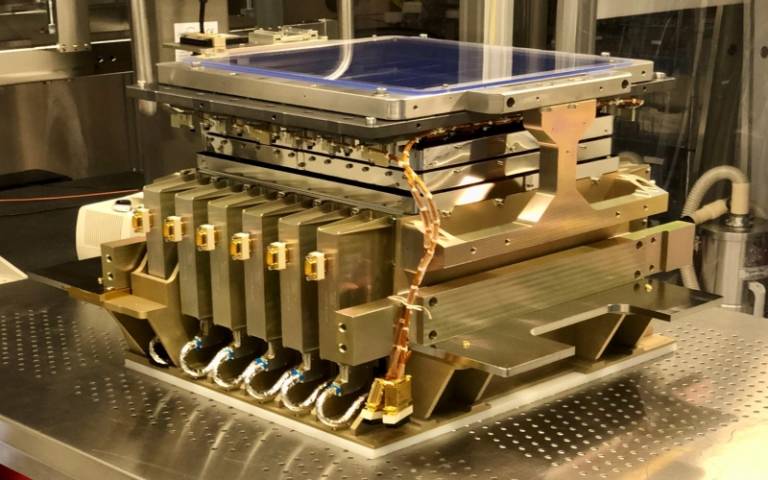Euclid space telescope’s camera a step closer to imaging galaxies
9 July 2020
ESA’s Euclid mission to study more than a billion galaxies is a step closer to launch as its two instruments are now built and fully tested, including a massive optical digital camera delivered by an international consortium led by the UCL Mullard Space Science Laboratory.

Once Euclid is launched from French Guiana in 2022, the VIS instrument will be one of the largest such cameras put into space and will capture light from distant galaxies, providing a more detailed look at the visible universe over a larger part of the sky than ever before.
Euclid has a 1.2-metre mirror telescope that is designed to work at both visible and near-infrared wavelengths. It will collect light from distant cosmic objects and feed it into VIS and another instrument, the Near Infrared Spectrometer and Photometer (NISP).
Euclid will survey the shapes of galaxies and map the geometry of the Universe with the aim of making accurate measurements of mysterious Dark Matter and Dark Energy, which make up most of the cosmos. No-one yet knows what Dark Energy is, but Euclid will be a powerful tool for astronomers looking to find out.
Dr Yannick Mellier (Institut d'astrophysique de Paris, CNRS/Sorbonne Université and CEA/Irfu, Saclay), lead of the Euclid 1500-strong Consortium of which VIS is a part, said “Euclid will revolutionize our knowledge of the Universe by making the most accurate measurements of Dark Matter and Dark Energy, testing whether Einstein's theory of General Relativity requires modification, weighing neutrinos and exploring the details of how galaxies evolve.”
The VIS instrument was delivered by a team of astronomers and engineers from UCL and The Open University in the UK, with teams at CEA-Irfu, Institute for Research on the Fundamental Laws of the Universe of the CEA (The French Alternative Energies and Atomic Energy Commission) and Institut d'astrophysique spatiale (IAS, CNRS/Université Paris-Saclay) in France, Istituto di Astrofisica e Planetologia Spaziali (IAPS) in Italy and the University of Geneva in Switzerland.
VIS and the Euclid telescope are built to be incredibly stable and to take very sharp high-resolution images in order to measure the shapes of galaxies with sufficient accuracy. To do this, the instrument has a mosaic of 36 CCDs, to give a total of just over 600 megapixels.
Professor Mark Cropper (UCL MSSL), leader of the VIS instrument team, said: "The VIS camera will take pictures of entire sky that is accessible for large scale cosmology and reach out to the most distant parts of the universe over the course of six years. Each of these images will be more than 70 times larger than those captured using the Hubble Space Telescope and will contain information useful for all fields of astronomical research. They will be available for astronomers and the public alike, allowing everyone to enjoy the beauty of the Cosmos.”
VIS has been funded by the UK Space Agency, and those of France, Italy and Switzerland, and has benefitted from support from the Euclid Consortium and from close cooperation with ESA.
The UCL team provided the system-level role, and produced, tested and calibrated the electronics for the detector array to ensure they survive the cold environment of space.
The structure for the camera was produced by CEA, the shutter by the University of Geneva, a calibration unit by IAS, a unit to operate these two by CEA, and a powerful data processing unit to capture all of the 144 individual channels from the camera and to control the instrument by IAPS.
Professor Andrew Holland (Centre for Electronic Imaging at The Open University and co-investigator for Euclid VIS), added: "The VIS instrument contains one of the largest detector arrays to be used in space and its demanding science goals have required the development of new operating modes and experimental techniques to enhance the quality of science data returned and to extend the Euclid mission lifetime. This research will inform and enhance future space missions going forward."
The NISP instrument, which is being built by a consortium of nationally funded institutes led by the Laboratoire d'astrophysique de Marseille (LAM, CNRS/AMU/CNES) in France, is dedicated to making distance measurements of galaxies. With VIS, it will allow Euclid’s data to be turned into the largest, most accurate 3D survey of the Universe ever conducted.
The UK Space Agency’s Head of Space Science, Caroline Harper said: “We know very little about Dark Energy and Dark Matter, and yet many astronomers believe that together they make up an incredible 95% of the Universe. Euclid will help us unlock some of their secrets by imaging more than a billion galaxies in more detail than ever before."
Now that the instruments have been delivered to Airbus, they will be integrated first with the telescope, and next with the rest of the payload module, which will take several months to ensure everything is precisely aligned and electronically communicating.
It has been a long journey getting this far. Euclid was selected for implementation in 2011, having already undergone almost five years of studies. While there is still a lot of hard work and testing ahead, the delivery of the instruments and telescope means that the spacecraft is now really beginning to come together.
Links
- Professor Mark Cropper's academic profile
- UCL Mullard Space Science Laboratory
- UCL Space & Climate Physics
- UCL Mathematical & Physical Sciences
- ESA Euclid Mission
- CEA
- CNRS
Images
- The VIS Focal Plane. The 36 dark blue CCDs are held in the grey Silicon Carbide structure seen here under a protective cover (to be removed before launch) at the top of the unit, while the electronics to measure and digitize the images are in the gold structure below with their power supplies on the outside. The silver sections are the thermal shrouds which isolate the cold CCDs from the warm electronics. Image credit: CEA
Source
Media contact
Bex Caygill
Tel: +44 (0)20 3108 3846
Email: r.caygill [at] ucl.ac.uk
 Close
Close

